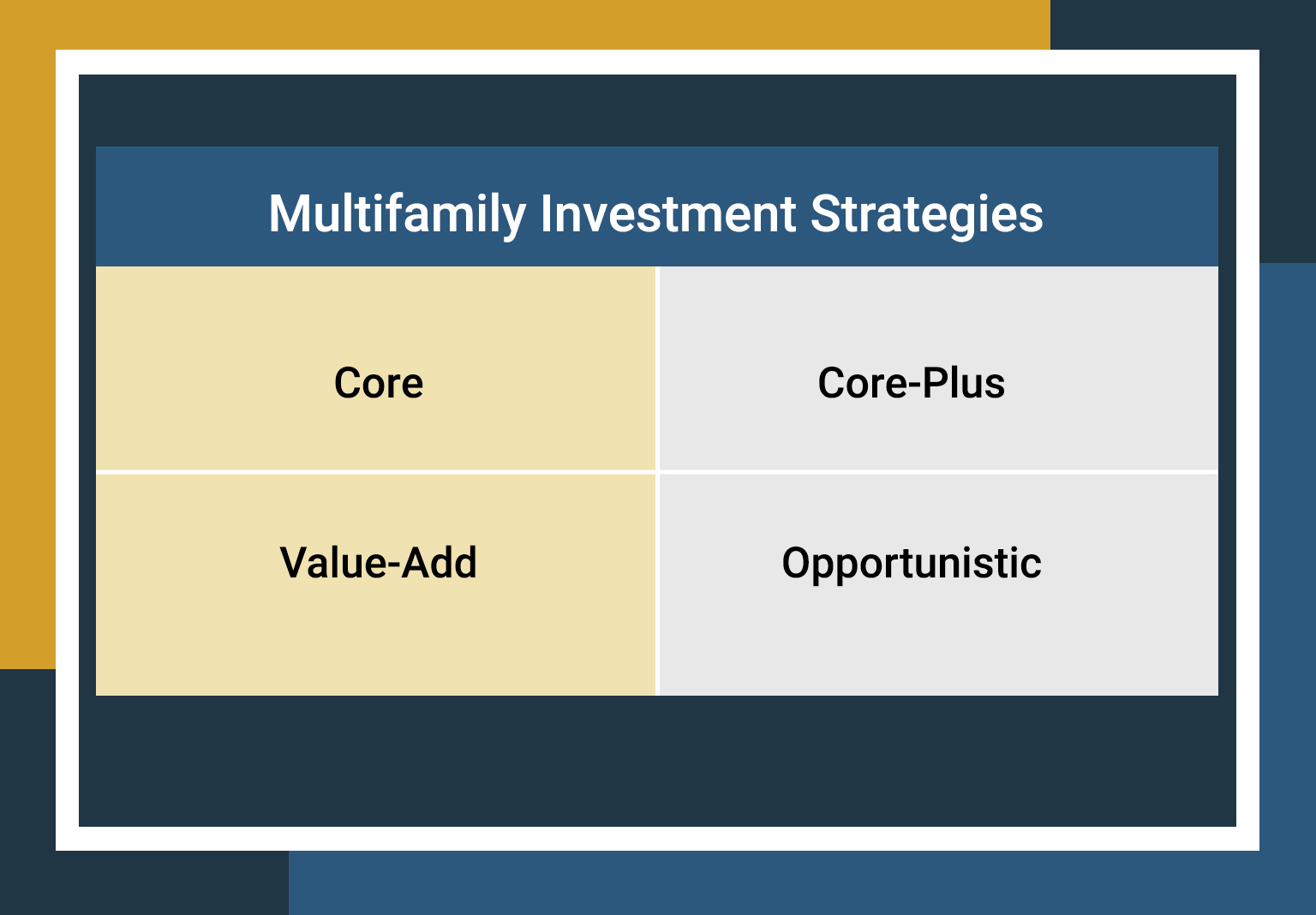Investors are always on the lookout for the next game-changing addition to enhance their investment strategy. On this quest, many explore alternative investment avenues, with real estate often standing out as a compelling choice. Like in any investment landscape, real estate features distinctive sectors, such as multifamily investing, which possess inherent advantages that consistently captivate the interest of investors.
But even within multifamily investing, many different approaches exist. So, what is a good multifamily investment strategy? What determines if a strategy is “good” or not depends on a variety of factors, which we will discuss.
| Discussion Topics |
Understanding Multifamily Investment Strategies
When it comes to real estate investing, the multifamily sector is an attractive option for investors who are looking for cash flow and other potential benefits, such as diversification economies of scale and a hedge against inflation.
The Four Main Multifamily Investment Strategies
| Core | The core investment strategy focuses on providing investors with the most stable approach to multifamily investing. This typically involves purchasing or investing in properties in prime locations that are already leased and have reliable tenants. Ideally, this strategy will preserve capital and provide a stable, predictable income stream but likely won’t offer the most exciting returns. |
| Core-Plus | Core-plus is a strategy designed to balance stability and growth, making it a compelling choice for investors seeking higher returns than a core strategy. In this approach, properties acquired typically feature latent potential that can be harnessed through minor enhancements or strategic leasing efforts, thereby paving the way for potential increases in property value and higher potential returns. |
| Value-Add | Value-add is all about unlocking the hidden potential of multifamily properties. This strategy is more hands-on than core and core-plus, as it uses properties that require more improvements and may be underperforming due to management issues, outdated amenities, or poor maintenance. By making changes and renovations, investors can potentially increase their returns, albeit with higher risk than core or core-plus strategies. |
| Opportunistic | This is the riskiest strategy, but it also has the potential to be the most lucrative. An opportunistic approach involves the acquisition of distressed or severely underperforming properties, often in dire need of extensive improvements. The goal is to revitalize these properties, enhancing their value and unlocking the potential for significant returns. However, given its inherent risk, this strategy demands an in-depth comprehension of the market, substantial financial resources, and the ability to handle complex challenges. |
What Is a Good Multifamily Investment Strategy?
When deciding which multifamily investment strategy is right for you, it’s essential to understand that choosing the right one depends on factors such as your risk tolerance, financial resources, and investment goals.
Things to Consider When Choosing a Strategy
- Risk Tolerance: Some investors prefer a more conservative approach and stable returns. These investors might choose core or core-plus. Those with higher risk tolerance may find value-add or opportunistic investments more appealing since they have the potential for higher returns.
- Capital and Expertise: Value-add and opportunistic investors often need substantial financial resources and a deeper understanding of real estate market dynamics than core and core-plus investors.
- Investment Horizon: Consider your investment horizon. Core and core-plus investment strategies tend to be held longer than value-add and opportunistic strategies.
- Market Conditions: Always assess the local real estate market and economic conditions. Different strategies may be more or less favorable depending on these factors.
Considering these factors will help you decide which investment strategy best aligns with your goals and objectives.
Comparing Investment Strategies | ||
Key Features | Appropriate Scenarios | |
Core |
|
|
Core-Plus |
|
|
Value-Add |
|
|
Opportunistic |
|
|
Multifamily real estate provides investors with a multitude of options to explore when shaping their investment strategy. However, there is no “best” multifamily investment strategy, as there is no one-size-fits-all approach. Each strategy comes with a unique set of context-dependent advantages and disadvantages. Consequently, discovering a sound investment strategy necessitates aligning these strategies with individual financial capabilities and objectives.
Moreover, while some strategies are riskier than others, all investments carry some level of risk. Always consult with a financial advisor before making any investment decision.
Canyon View Capital Offers Risk-Averse Multifamily Investment Options
Figuring out the best multifamily investment strategy can be challenging, as many factors must be considered. However, the benefits of investing in multifamily real estate may make it worthwhile for some investors.
Canyon View Capital offers solutions for risk-averse investors or investors who don’t want to spend significant hands-on time with their multifamily investments. Our portfolio of multifamily properties, now valued at over $1 billion, is backed by our “buy-and-hold” strategy that provides the potential for passive real estate income and passive losses that may reduce tax burdens.
Still need more information on the IRA Alternative Investments?
12$1B figure based on aggregate value of all CVC-managed real estate investments valued as of March 31, 2023.
Eric Fisher, Chief of Staff
Eric joined Canyon View Capital in August 2021 with 15 years of hotel management experience grounded evenly between Property & Corporate Operations, and Business Development & Acquisitions. After $500M+ in hotel acquisitions, Eric uses his nuanced understanding of the acquisitions and transitions processes to support CVC real estate investments. His professional versatility makes Eric an invaluable resource for the President and Executive Team in all business functions, including Investments, Operations, and Strategy.


